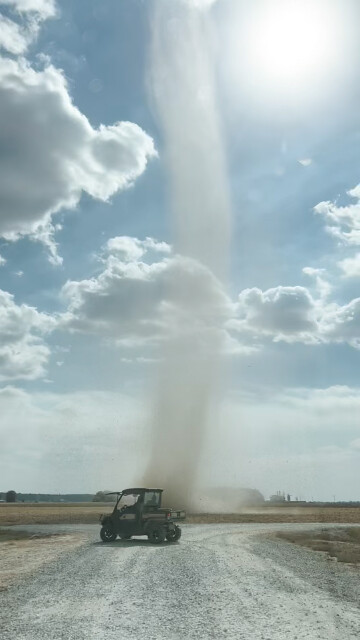Giant dust devil turns Tuesday into 'Windsday' at rice research center
Tuesday’s “dust devil was just beautiful to watch," Matt Conatser said.
By Mary Hightower
U of A System Division of Agriculture
Oct. 13, 2022
Fast facts
- Warm, sunny days conducive to dust devils
- Whirlwinds rarely cause damage
(614 words)
(Newsrooms: with stills, video at https://flic.kr/s/aHBqjAaSDH)
GREENFIELD, Ark. — Tuesday was a real whirlwind of a day for Tim Burcham.
Burcham, director of the Northeast Rice Research and Extension Center in Poinsett County, and Wyatt Luebke, assistant farm manager, were headed to the field in a side-by-side utility vehicle when they were faced with an enormous dust devil.
Burcham — arms raised and with a smile on his face — jumped from the vehicle and ran straight at the vortex. Luebke’s video of the event has been viewed thousands of times on Twitter.
“How many times in your life do you get an opportunity to get that close to one of nature’s weather phenomena?” Burcham said on Wednesday, adding it was “really a cool feeling” to get that close.
“I got pelted by some of the corn shucks in the whirlwind, but nothing painful. There were corn shucks at least 200-300 feet into the air,” he said. “This whirlwind was even more spectacular due to the extreme drought conditions at the farm which allowed it to pick up extensive amounts of soil as well as the corn shucks!”
“Work on the station can be hot, dusty, and consume long hours,” Burcham said. “Anytime we get an opportunity to inject some safe levity, I believe it’s good for morale.”
Matt Conatser, a program technician working at the station, also filmed the dust devil. His video shows the side-by-side in front of the swirl of dirt and debris, capturing its scale. Conatser’s video had more than 8,000 views by Thursday morning.
While it’s not the first big dust devil he’s ever seen, “this one was the biggest for sure,” he said. “I rode my bike through another one when I was about 9 years old and it threw me around a little.”
Tuesday’s “dust devil was just beautiful to watch,” Conatser said. “While it was quite powerful for a dust devil, it definitely wasn't dangerous. At the end of the video, you can hear it hit the shop building as it was dissipating, so it did pack a bit of a punch.
“It was just fun to take a couple minutes to watch and enjoy,” he said.
Conatser also captured the moment when Burcham made his run.
“What I love about Tim is that he doesn't let an opportunity go to waste,” Conatser said. “He is there in the moment and ready to engage!”
How dust devils form
Pat Walker, meteorologist for KARK-TV in Little Rock, said dust devils occur on warm, sunny days.
“When there is such a significant difference in temperature between the surface and air a few hundred or even a thousand feet up, the air from the surface rises very quickly into the cooler air above,” he said. “We call these pockets of rising air ‘thermals.’
They’re most likely to occur between noon and 4 p.m., when the ground’s surface is warmest.
“When the warm air lifts and vacates the surface, something has to replace it — vacuums aren’t allowed in our atmosphere,” Walker said. “Cooler air rushes in from all directions.”
With so much air rushing in, “there’s not room enough for all of it,” he said. “So, it has to come in, in a swirling motion — hence, the dust devil.”
Walker said that once the thermal has lifted sufficiently to balance the temperature difference between the surface and air aloft, “the vertical motion stops … and the dust devil dies off.”
Dust devil winds can reach 60 miles per hour or greater, but rarely cause damage, according to the National Weather Service.
The Northeast Rice Research and Extension Center is part of the Arkansas Agricultural Experiment Station, the research arm of the University of Arkansas System Division of Agriculture.
To learn about extension programs in Arkansas, contact your local Cooperative Extension
Service agent or visit www.uaex.uada.edu. Follow us on Twitter and Instagram at @AR_Extension. To learn more about Division
of Agriculture research, visit the Arkansas Agricultural Experiment Station website: https://aaes.uada.edu. Follow on Twitter at @ArkAgResearch. To learn more about the Division of Agriculture,
visit https://uada.edu/. Follow us on Twitter at @AgInArk.
About the Division of Agriculture
The University of Arkansas System Division of Agriculture’s mission is to strengthen
agriculture, communities, and families by connecting trusted research to the adoption
of best practices. Through the Agricultural Experiment Station and the Cooperative
Extension Service, the Division of Agriculture conducts research and extension work
within the nation’s historic land grant education system.
The Division of Agriculture is one of 20 entities within the University of Arkansas System. It has offices in all 75 counties in Arkansas and faculty on five system campuses.
Pursuant to 7 CFR § 15.3, the University of Arkansas System Division of Agriculture offers all its Extension and Research programs and services (including employment) without regard to race, color, sex, national origin, religion, age, disability, marital or veteran status, genetic information, sexual preference, pregnancy or any other legally protected status, and is an equal opportunity institution.
# # #
Media contact: Mary Hightower, mhightower@uada.edu
